Phytochemical profile, mineral composition, antimicrobial, antioxidant and anti-breast cancer activities of Sambucus ebulus
IF 1.7
4区 医学
Q3 INTEGRATIVE & COMPLEMENTARY MEDICINE
引用次数: 0
Abstract
Introduction
Sambucus ebulus, belonging to the Sambucus genus, is important in folk medicine, used to treat stomach pain, rheumatism, eczema, high fever, colds, coughs etc., and also in cancer treatment in Turkish traditional medicine. This study outlines the antioxidant, apoptotic, cytotoxic, antimicrobial activity, and phenolic profile of the water and ethanol extract of S. ebulus and provides its mineral elements.
Methods
The antioxidative capacity of the sample was identified by using radical scavenging (DPPH (2,2-diphenyl-1-picrylhydrazyl radical), ABTS (2,2′-azino-bis (3-ethylbenzothiazoline-6-sulfonic acid)), reducing (CUPRAC (cupric reducing antioxidant capacity), FRAP (ferric ion reducing antioxidant power)), metal chelating, and phosphomolybdenum methods. Cytotoxic effects of the extract were determined by XTT (2,3-Bis-(2-Methoxy-4-nitro-5-sulfophenyl)-2H-tetrazolium-5-carboxanilide, disodium salt) assay. Expression changes of genes related to apoptosis (Bcl-2, Bax, caspase-3,-8,-9) were analysed by real-time PCR (Polymerase Chain Reaction). Antimicrobial activities of the extracts were investigated by disc diffusion assay, and the MIC (minimum inhibitory concentration) values were determined. The phenolics were analysed via HPLC analysis.
Results
The water extract exhibited higher radical scavenging and reducing activities than the ethanol extract. The water extract also exhibited better antimicrobial activity against gram-negative bacteria than gram-positive bacteria. The highest inhibition zone was determined for the water extract against C.albicans. S. ebulus showed apoptotic and cytotoxic effects on the breast cancer cell line. Caffeic acid and epicatechin were the main phenolic compounds identified using HPLC (High performance liquid chromatography).
Conclusion
The results of this study are expected to contribute to ongoing efforts to identify novel plant-derived antioxidants, antibiotics, and anticancer agents. Furthermore, the findings highlight the potential of S. ebulus as a valuable natural antioxidant and suggest its possible use as a beneficial dietary supplement for therapeutic applications.
山参的植物化学特征、矿物成分、抗菌、抗氧化和抗乳腺癌活性
沙参属的沙参属在民间医学中占有重要地位,用于治疗胃痛、风湿、湿疹、高烧、感冒、咳嗽等,在土耳其传统医学中也用于治疗癌症。本研究概述了黄茎水提取物和乙醇提取物的抗氧化、细胞凋亡、细胞毒性、抗菌活性和酚类成分,并提供了其矿物元素。方法采用自由基清除法(DPPH(2,2-二苯基-1-吡啶肼基自由基)、ABTS(2,2 ' -氮基-双(3-乙基苯并噻唑-6-磺酸))、还原法(CUPRAC(铜还原抗氧化能力)、FRAP(铁离子还原抗氧化能力))、金属螯合法和磷钼法鉴定样品的抗氧化能力。采用XTT(2,3-双-(2-甲氧基-4-硝基-5-磺胺基)- 2h -四氮唑-5-羧基苯胺二钠)法测定提取物的细胞毒作用。real-time PCR (Polymerase Chain Reaction)分析凋亡相关基因Bcl-2、Bax、caspase-3、-8、-9的表达变化。采用圆盘扩散法测定其抑菌活性,并测定其最低抑菌浓度(MIC)。用高效液相色谱法分析酚类物质。结果水提物比乙醇提物具有更强的自由基清除和还原活性。水提物对革兰氏阴性菌的抑菌活性优于革兰氏阳性菌。水提物对白色念珠菌的抑制区最高。对乳腺癌细胞株有凋亡和细胞毒作用。高效液相色谱法鉴定出主要的酚类化合物为咖啡酸和表儿茶素。结论本研究结果将为开发新的植物源抗氧化剂、抗生素和抗癌药物提供参考。此外,研究结果强调了黄茎霉作为一种有价值的天然抗氧化剂的潜力,并建议其作为一种有益的膳食补充剂用于治疗应用。
本文章由计算机程序翻译,如有差异,请以英文原文为准。
求助全文
约1分钟内获得全文
求助全文
来源期刊

European Journal of Integrative Medicine
INTEGRATIVE & COMPLEMENTARY MEDICINE-
CiteScore
4.70
自引率
4.00%
发文量
102
审稿时长
33 days
期刊介绍:
The European Journal of Integrative Medicine (EuJIM) considers manuscripts from a wide range of complementary and integrative health care disciplines, with a particular focus on whole systems approaches, public health, self management and traditional medical systems. The journal strives to connect conventional medicine and evidence based complementary medicine. We encourage submissions reporting research with relevance for integrative clinical practice and interprofessional education.
EuJIM aims to be of interest to both conventional and integrative audiences, including healthcare practitioners, researchers, health care organisations, educationalists, and all those who seek objective and critical information on integrative medicine. To achieve this aim EuJIM provides an innovative international and interdisciplinary platform linking researchers and clinicians.
The journal focuses primarily on original research articles including systematic reviews, randomized controlled trials, other clinical studies, qualitative, observational and epidemiological studies. In addition we welcome short reviews, opinion articles and contributions relating to health services and policy, health economics and psychology.
 求助内容:
求助内容: 应助结果提醒方式:
应助结果提醒方式:


